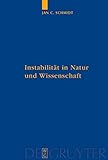Instabilität in Natur und Wissenschaft : Eine Wissenschaftsphilosophie der nachmodernen Physik / Jan Cornelius Schmidt.
Material type: TextSeries: Quellen und Studien zur Philosophie ; 81Publisher: Berlin ; Boston : De Gruyter, [2008]Copyright date: ©2008Description: 1 online resource (459 p.)Content type:
TextSeries: Quellen und Studien zur Philosophie ; 81Publisher: Berlin ; Boston : De Gruyter, [2008]Copyright date: ©2008Description: 1 online resource (459 p.)Content type: - 9783110195651
- 9783110209693
- 530.01 22/ger
- B23 .Q45 Bd.81
- online - DeGruyter
- Issued also in print.
| Item type | Current library | Call number | URL | Status | Notes | Barcode | |
|---|---|---|---|---|---|---|---|
 eBook
eBook
|
Biblioteca "Angelicum" Pont. Univ. S.Tommaso d'Aquino Nuvola online | online - DeGruyter (Browse shelf(Opens below)) | Online access | Not for loan (Accesso limitato) | Accesso per gli utenti autorizzati / Access for authorized users | (dgr)9783110209693 |
Habilitation TU Darmstadt 2006.
Frontmatter -- Inhalt -- 1. Einführung. Wege durch den Wandel der Wissenschaften -- Teil I: Klassisch-moderne Physik -- 2. Klassisch-moderne Physik. Skizze des Referenzsystems -- Teil II: Instabilitäten -- 3. Systematische Aspekte der Instabilitäten. Zur Problematisierung der klassisch-modernen Physik (I) -- 4. Wissenschaftshistorische Wege der Instabilitäten. Zur Problematisierung der klassisch-modernen Physik (II) -- Teil III: Nachmoderne Physik -- 5. Über Genese und Geltung. Wissenschaftstheoretische Erweiterung zur nachmodernen Physik -- 6. Über Natur, Welt und Wirklichkeit. Wissenschaftsinhaltliche Erweiterung zur nachmodernen Physik -- 7. Über Zugänge und Ziele. Wissenschaftsprogrammatische Erweiterung zur nachmodernen Physik -- 8. Resümee -- Backmatter
restricted access online access with authorization star
http://purl.org/coar/access_right/c_16ec
Dass Natur nicht nur stabil und statisch, sondern auch instabil und dynamisch ist, hat die Physik in den letzten 40 Jahren zeigen können. Instabilitäten gelten mittlerweile als produktive und kreative Quellen des Werdens und Wachstums. Von Selbstorganisation, Chaos und Komplexität, Zeitlichkeit und Zufall ist vielfach die Rede. Dieser Wandel im Naturverständnis hat Rückwirkungen auf die Wissenschaften. Traditionell hatte sich die Physik an Stabilität orientiert. Heutzutage erneuert und erweitert sie sich: Eine nachmoderne Physik der Instabilitäten tritt hervor und zeigt reichhaltige interdisziplinäre Perspektiven auf.
Nature is not only stable and static but also unstable and dynamical - this has been shown by physics during the last 40 years. Today, instabilities are regarded as productive and creative sources of change, pattern formation, and growth. They constitute the nomological nucleus of self-organization, chaos and complexity, time's arrow and chance. This change in understanding nature has also modified sciences. Physics has traditionally limited its scope to stability. Currently, it is expanding and renewing itself: a late-modern physics is emerging, and discloses rich interdisciplinary perspectives for the future of mathematical sciences.
Issued also in print.
Mode of access: Internet via World Wide Web.
In German.
Description based on online resource; title from PDF title page (publisher's Web site, viewed 28. Feb 2023)


